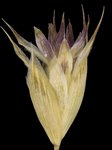
T. lanigera spikelet.

T. lanigera habitat, sandplain.
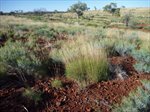
T. lanigera habitat, rocky.
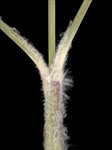
T. lanigera habitat, sandplain.
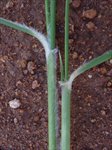
T. lanigera orifice, less woolly form.
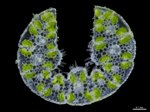
T. lanigera leaf section.
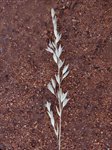
T. lanigera inflorescence.
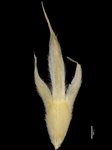
T. lanigera lemma.
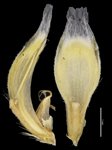
T. lanigera paleas.

T. lanigera map.
Name
Triodia lanigera Domin
Citation
J. Linn. Soc., Bot. 41: 278 (1912)
Derivation
lanigera — from Latin lana, wool, and –ger, bearing, in reference to the woolly orifices and (usually) sheathsCommon name
Woolly Spinifex
Synonyms
None
Diagnostic features
Foliage non-resinous; leaf sheath surfaces glabrous or woolly; orifice hairs woolly, the hairs extending onto the base of the blade and often also the leaf sheaths; leaf blades amphistomatous (hard-type), the longest leaves usually >15 cm long; inflorescence branched; longest basal pedicels >3 mm long; lower glume 7–17-nerved; lemmas lobed for half or more of length, not awned (but midlobe may be elongated); lowest lemma midlobe 4.2–11 mm long; lemma body bitextured, with the lower part indurated and the upper part membranous; callus 0.8–1.5(–1.8) mm long; on sand or rocky substrates in the central and eastern Chichester sub-region.
Habitat
Occurs on sand flats or rocky plateaus, or sometimes on the rocky slopes of low hills.
Distribution and frequency
Endemic to the north Pilbara, where it occurs throughout the central and northeastern parts of the Chichester sub-region. Common and abundant especially on sandy plains, but somewhat patchy.
Similar species
Triodia lanigera is a member of the Basedowii group, sharing the group features of non-resinous foliage, amphistomatous (hard-type) leaf blades and many-nerved (≥6) glumes. Triodia lanigera is distinguished from all Basedowii group species except T. basedowii by a combination of long leaves (longest leaves usually >15 cm long), orifice woolly-hairy with the hairs extending onto the surface of the blade and often also the sheath surfaces, branched inflorescence and lemmas distinctly lobed for half or more of their length. Triodia lanigera can be distinguished from T. basedowii by having a longer callus 0.8–1.5(–1.8) mm long, compared to (0.2–)0.5–1.0 mm long in T. basedowii, and often has a longer lowest lemma midlobe (4.2–11 mm) compared to T. basedowii which is (3.2–)3.5–5.5(–7) mm long.
The distribution of T. chichesterensis in the central Chichester sub-region overlaps only with T. lanigera, with which it co-occurs and occasionally hybridizes. Triodia lanigera can be distinguished by having woolly leaf sheaths (in the area of overlap), longer leaf blades with longest leaves usually >12 cm long and larger inflorescences having 5–38 spikelets and (0)2–9 branches bearing more than one spikelet (T. chichesterensis has glabrous leaf sheaths, leaf blades 3–11 cm long, and inflorescences with 4–11 total spikelets and 0–3 branches bearing more than 1 spikelet).
Previously confused with Triodia glabra which is disjunct in the western Pilbara and Carnarvon bioregion, but the two species can be distinguished by leaf orifice hairs glabrous or less often with ± straight hairs up to 2.5 mm long in T. glabra, compared to woolly in T. lanigera; the woolly hairs in T. lanigera usually also extending to the sheath surfaces.Conservation status
Not considered at risk.
Identification without florets
The combination of amphistomatous (hard-type) leaf blades, many-nerved (≥6) glumes, and distribution in the central and eastern Chichester region distinguishes T. lanigera from all species except T. basedowii, T. chichesterensis and T. scintillans.
Where T. lanigera and T. basedowii occur in close proximity north of Munjina (Auski), T. lanigera either has woolly leaf sheaths OR occurs on rocky to gravelly soils on the Chichester plateau, while T. basedowii is restricted to the plains of the Fortescue Valley, and in that area always has glabrous leaf sheaths (can be woolly outside of the Pilbara bioregion).
Triodia scintillans has minute droplets on the young leaf sheaths, and shorter leaves 4–10(–13.7) cm long (lacking droplets and usually at least some leaves >15 cm long in T. lanigera).
Triodia lanigera can be distinguished from T. chichesterensis by the characters noted above.
Variation
Over most of its range, T. lanigera plants form large hummocks and have the central midlobe of the lemma prominently elongated well past the lateral lobes, however plants north of the Fortescue River Valley on the Great Northern Highway have generally smaller hummocks and have subequal lemma awns. These southern plants are genetically a little divergent from the rest of T. lanigera, but are included within a broad concept of T. lanigera (Anderson et al. 2016, 2017a, b).
Occasional hybrids between T. chichesterensis and T. lanigera exist and span the range of intermediate morphology between the two species.Notes
Hybrids between T. chichesterensis and T. lanigera are known from two localities where the two species co-occur.
The concept of T. lanigera in Lazarides (1997), Lazarides et al. (2005) and Ausgrass (Sharp & Simon, 2002; Simon & Alonso, 2014) included forms now segregated as T. chichesterensis and T. glabra.
A full description of T. lanigera can be found in Anderson et al. (2017a).
Not palatable to stock, except that inflorescences can be highly sought when fresh and mature (Burbidge 1946, MB & BA observations).
Apparently always killed by fire, and does not resprout (MB obs.).